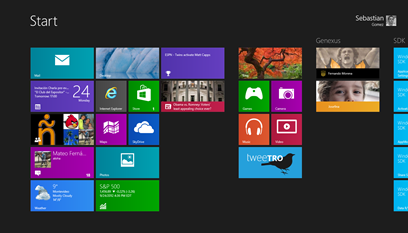The Windows Store apps ecosystem
It’s been pretty exciting lately with all the announcements from Microsoft. Windows 8 finally came out, we saw the Surface tablet and other some really cool devices, and today Windows Phone 8 was announced to hit the stores in a few days.
I’ve been using Windows 8 since the developer preview and of course it takes some time to get used to it, but if you think about it, and you actually DON’T think too hard about it, Windows 7 keyboard shortcuts work as expected on Windows 8. So if you’re a keyboard wiz, you will have no trouble to find your way around.
What I like about all this new wave is the concept of one app in many devices. I don’t have an Xbox (yet) but being able to take a photo with my phone and have sent over my my notebook, tablet or favorite social network, is (for me) a big step forward. I know people with iPhone and Android devices will say “hey, I can do that with my phone already”, I know. I know it’s not rocket science, I’m just saying it’s a time saver to have it now with Windows, the OS my whole family uses… so now my mom won’t be calling me to help her hook the camera with the computer (that’s not a good example since she’s got an iPad, but you get the idea).
What I don’t like for what I’ve seen so far? The Windows Store. I guess Microsoft didn’t think it would grow-up so fast… the Windows Store as we know will NOT scale up. It’s already difficult to find an app. I don’t know what others have done, but it’s almost impossible to find a game I would like with such an awful layout. At this moment the games category has 1033 apps (games) laid out awfully, so unless you’re looking for Angry Birds or Cut the Rope, it’s frustrating to go in there in pursuit of a cool game. I’ve shut the window store app many times without a single download.
Another weird thing is how many apps have the default Visual Studio 2012 templates images. Either from previous preview versions as for the official released version, I’m talking about the little cross in a box or the star. What’s up with that? Why is Microsoft allowing those crappy looking apps into the store?… there’s no way in hell I’ll even pay attention to an app that’s was not paid attention in the first place from its own developers. That not only increases the amount of apps, which in this case is not good, but it also gives the impression of “beta”… and I’m not talking about the apps, I’m talking about the store.
I know what’s going on. There are a bunch of Microsoft developers who saw how others got rich with apps for iOS and/or Android. Nobody thought that could be possible. Even so, five years ago there were 0 (zero) iOS developers, today they say there more than a quarter million. While those “developers” made millions of apps, some Microsoft developers waited for Microsoft to come up with something, and now it did. And I bet those developers thought, “ok, now is my turn. I know this shit, I’ll get a Windows Store app in no time”. Well my friend, you don’t know shit about Windows Store apps. Actually nobody knows, we’re all learning about it, and if you take a look at the official Microsoft made apps, you’ll see they are also learning. So don’t give me that “I know Silverlight and Xaml, I know what I’m doing” cause your app will look like crap if you don’t sit down and read the tons of guidelines out there about Windows Store apps.
I’ve heard a lot lately that the Surface is great; great hardware but no good apps. I can’t believe there’s no facebook app, aren’t you guys friends anymore? and no official twitter app either? I just hope it’s not attempt from Microsoft to “make us” use IE10 instead, like they’re doing with Xbox.
The good news is, we’re making a Windows Store apps generator. I wrote before about it and showed some of the cool features you can take advantage of with our generator. You might be wondering what kind of apps can we build with this generator. Is it final consumer apps or is it enterprise level apps? Yes to both o them. There’s a big showcase of apps we have built with Genexus for iOS and Android, so expect the same apps for Windows 8 soon.
So, is there an app that you wish Windows 8 had but it is not there? Don’t wait for someone else to build something close to what you need. Download Genexus Tilo now, and start creating the next Windows 8 killer app.




![works-on-my-machine] works-on-my-machine]](http://lh4.ggpht.com/-J4Oyi75Yxiw/UGtytodK4jI/AAAAAAAAJk4/DKw2YblMKx0/works-on-my-machine%25255D_thumb%25255B2%25255D.png?imgmax=800)



![works-on-my-machine] works-on-my-machine]](http://lh6.ggpht.com/-fE3hjExf-tk/T15IFBLnmeI/AAAAAAAAItk/XcnFPcO5eEY/works-on-my-machine%25255D_thumb.png?imgmax=800)


